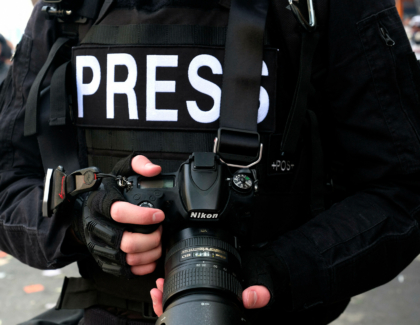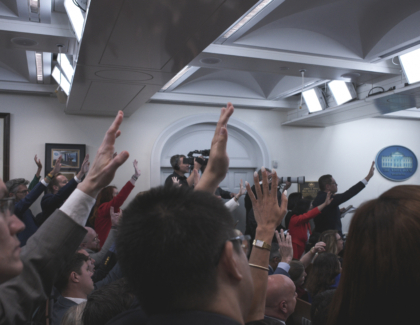Sign up for the daily CJR newsletter.
Alex Wood readily admits that he can be described as a “dissatisfied litigant.” And he would have good reason to be dissatisfied: the Freedom of Information Act lawsuit that he, with no formal legal training, personally saw through to a hearing in the Second Court of Appeals failed to net him a key document that he’d been after for almost seven years.
But most galling to Wood was the decision that ended his case, an “intellectually dishonest” “hatchet job” written by a federal judge whose questions during oral argument made him believe that key portions, at a minimum, of his brief went unread.
That judge? Sonia Sotomayor.
“This is a long story,” warns Wood, a reporter for the Journal Inquirer, a 38,000-circulation paper covering suburbs and towns to the east and north of Hartford, Connecticut. And it is only one chapter in Sotomayor’s record of decisions involving the Freedom of Information Act—although one not inconsistent with the Reporters Committee for Freedom of the Press’s evaluation that she “skewed more in favor of withholding records … than ordering their release” under the law.
For Wood, it is an unhappy chapter. The tale begins in the mid-nineties, when a handful of inspectors in the Connecticut Chief State’s Attorney’s office, detailed to work alongside FBI agents on a joint fugitive apprehension task force, alleged that the feds were falsifying information in arrest warrant affidavits.
In 1998, one inspector launched a federal civil lawsuit against his supervisor, claiming that he’d been denied promotions and transferred to a less desirable branch office because he discussed the scandal with outsiders. Months later, a jury found that retaliation had occurred, and awarded the inspector $2.7 million dollars, much of it in punitive damages. The state appealed, and during retrial the two sides agreed on a $1.5 million settlement.
“Part of the reason I covered that trial was my own interest in deception in law enforcement,” says Wood. “Before the case went to trial, I put in this Freedom of Information request to find out the facts behind the case.”
The submission asked the FBI and Justice Department for records related to their internal investigations of the allegations, which found that the FBI agents had sworn falsehoods, but resulted in nearly no consequences for the accused.
While Wood’s FOIA request was made shortly before the 1998 trial, the first documents, such as they were, came much later. “It took them a year and half to respond, and initially all I got was twenty-four pages of newspaper articles,” says Wood.
Wood was unsatisfied, and he weighed his options for a lawsuit that might compel the release of more records. But there was one major stumbling block.
“The issue was money,” remembers Wood, who asked three lawyers (two of whom represented state inspectors on the task force) to take the case pro bono or on the small chance they’d be able to recover costs.
“There weren’t any lawyers willing to do it,” says Wood. “And this newspaper certainly wouldn’t pay to do it.”
But Wood, who joined the Journal Inquirer in 1985 and had been covering the courts for over a decade, knew his way around the state’s law libraries and had good sources in the legal community. And he had filed some state-level freedom of information appeals before Connecticut’s court-like Freedom of Information Commission.
“If you do it long enough, you begin to learn some things,” he says. “So I decided to do it pro se.”
In November 2002, acting as his own attorney, Wood filed suit in Connecticut’s federal district court. By coincidence, his case was assigned to the district judge who had heard the inspector’s civil case four years before.
Even though Wood’s request had been denied in four administrative appeals, the agency proved quite responsive after the suit was filed.
“Essentially the FBI spilled their guts. They gave me almost the entire internal investigation, very lightly redacted,” says Wood. “My jaw dropped. I couldn’t believe they did that.”
He received over 400 full or partial pages of documents, including investigative interview reports, internal correspondence, and letters laying out the perfunctory administrative sanctions imposed upon the FBI agents in question. Together, they provided the backbone for three articles which, in 2003, were named the best investigative series in the Journal Inquirer’s circulation class by the Connecticut Society of Professional Journalists.
Still, Wood remained unsatisfied. Citing privacy exemptions to FOIA, the government had redacted the names of some of the Justice Department officials who had conducted the investigation. And they refused to release what Wood came to view as the crown jewel of the collection, a fourteen-page memo from the Justice Department’s Public Integrity Section that presumably recommended the infractions not be referred for prosecution.
So he focused his suit on the two remaining withholdings. But it was the memo that Wood really cared about. In March 2004, the district court ruled with Wood on some of the redacted names, but against him on the memo.
He prepared an appeal to the Second Circuit. “Frankly, I was pretty bullheaded about it,” he says.
A complicated web of case law governs FOIA’s fifth exemption, the portion of the law the government cited when deciding to withhold the memo. A 2004 Justice Department primer on exemption five gently notes that the exemption’s language is “somewhat opaque” and “sometimes confusing.” But precedent has established that agencies can withhold materials that are attorney-client communications, attorney work products, or that are predecisional—documents that were used to guide final agency decisions, but that are not, in fact, final decisions.
NLRB v. Sears, Roebuck & Co, a 1975 Supreme Court case, found that such information that is “expressly … adopt[ed]” as a final decision is eligible to be released. And Justice had released what it said was its final decision in the case—a scrawled note atop the withheld memo by the official responsible for deciding whether to prosecute, with the date, some initials, and the word “declined.”
But Wood asked the Second Circuit to consider instructions found in the U.S. Attorneys’ Manual, which requires federal prosecutors who decide not to prosecute after finding probable cause to “ensure that his/her decision and the reasons therefore … are reflected in the office files.”
“In other words, they’ve got to have something in their files that explains the reason for which they denied prosecution,” summarizes Wood. Whatever that document was, Wood argued, would be ripe for release—under the logic of Sears as interpreted by other appellate courts—as the reasoning behind the final decision.
Wood didn’t expect the court to order the document released. Instead, he hoped that the court would allow discovery on the Justice Department’s practices in such cases, which might firmly establish that the memo had been expressly adopted—had been the “reasons therefore” as discussed in the manual.
On September 21, 2005, Wood appeared before the New York based Second Circuit via a video link from a district court building in Hartford—“just not to blow a day riding the train back and forth,” he says—and argued his case. As a pro se litigant, he would only have five minutes to make his case before Sotomayor and the other judges.
“I was about ten, fifteen seconds into my argument when she interrupted with her first question,” remembers Wood. According to Wood’s recollection, Sotomayor first asked Wood if he was contending that the memo had to be released because it may have recommended declining prosecution—the same action the government chose. (CJR was unable to obtain a transcript of the session.)
“Basically she asked me a leading question that invited me to misstate the law,” says Wood. His brief hadn’t made that claim; instead, it contended that the memo may be eligible for release because it laid out the reasons adopted by the eventual decision, a point which Wood says he was able to make in court.
Over the course of questioning, Wood came to believe that Sotomayor wasn’t familiar with his arguments as presented in his brief. “I didn’t expect she’d read the whole thing, but she didn’t even read the parts of the brief she was interested in.”
As unhappy as he may have been during oral argument, Wood was even more dissatisfied when, in December 2005, the three judge panel issued its ruling, written by Sotomayor. His key piece of evidence that further discovery was warranted to determine if the memo had been expressly adopted, the Attorneys’ Manual, was dismissed in a footnote. Sotomayor didn’t quote the manual, and instead offered a paraphrase that made no mention of what Wood contends was the most important part.
“I think the omission of any reference to the language ‘and the reasons therefore’ in that footnote is intellectually dishonest,” Wood explains. “I think Judge Sotomayor and her colleagues owed it to me to at least acknowledge the existence of my main piece of evidence that this memo was adopted as the rationale for the decision to decline prosecution.”
Wood worked out a deal with the Justice Department that saved either side from having to pay the other’s expenses, and decided not to appeal to the court’s full bench, or to seek another hearing before the same three-judge panel.
“I didn’t trust them to take it seriously,” says Wood.
CORRECTION, 6/8: The article has been corrected to reflect the fact that Wood appeared before the Second Circuit via a Hartford videolink, not one in New Haven. In addition, several minor changes have been made to more precisely portray the state office employing the whistle blowing inspectors, the records protected by exemption 5, as well as Wood’s discovery requests and appeal options.
Has America ever needed a media defender more than now? Help us by joining CJR today.






